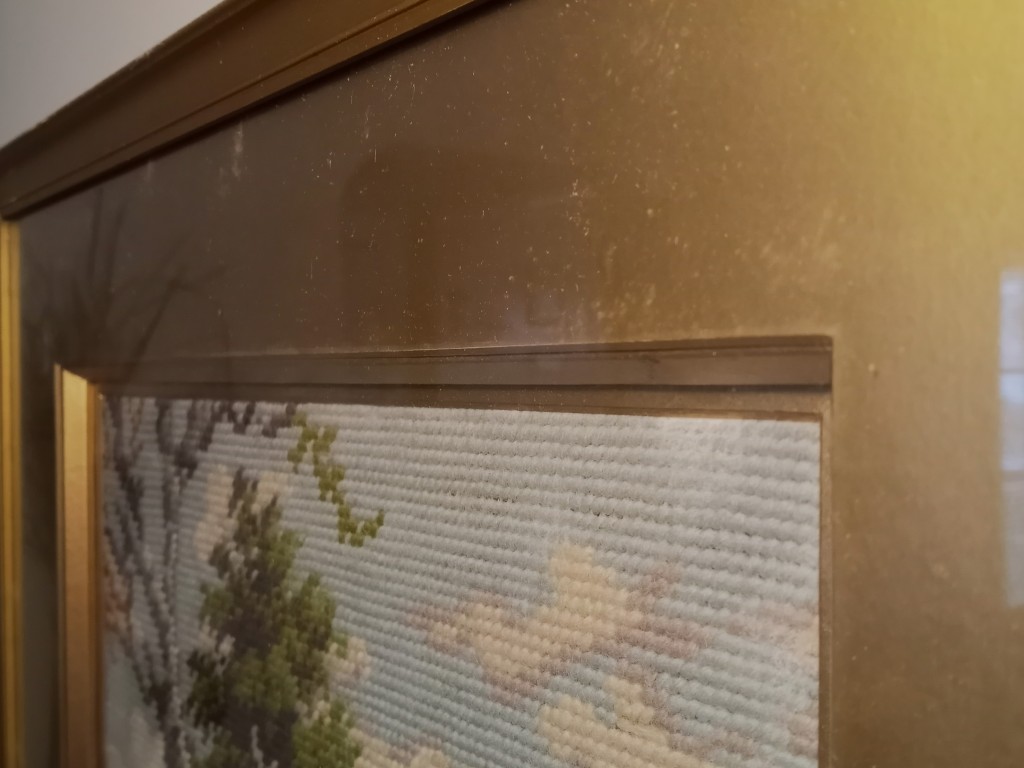
Both literally (optically, perceptually, physically) and figuratively (frame as demarcation; context definer) the frame matters. This illustration is a family heirloom from the 1920s or maybe a generation or two before that. So the frame in gold is original to the time and not a modern reinterpretation of the needlepoint art. It is one of three or four landscapes, all framed to match. If the same piece of art were in a modernistic “frameless” mount the viewing experience would be altogether different. Or if it were bordered in velvet, in chrome, or in deep red the art would take on a different complexion and thereby be regarded “in a new light” (physically the light would seem different; psychologically the impression of the scene would be altered somehow, too).
Observers of society in Japan* sometimes comment on the complexity and effort expressed in wrapping and packaging valuable products (and metaphorically ‘wrapping’ of services presented/performed, too; titles granted, seating order and protocol). That is not just a legacy of craftsmanship, a delight in visual, a history of ambient harm (climate, natural disasters and human dangers) to guard against, but it comes also from the effect that framing a thing can have. Careless and absence of wrapping somehow diminishes or obscures the subject matter. Going above and beyond functional, basic boxing, bundling, or wrapping shines a spotlight on the subject matter, heightening attention and value seen in the thing. Jumping to the example of food: some analysts say that half the taste in a meal comes from atmosphere at restaurant, home, or take-out presentation of the food. Portions served from the very same pan or oven can produce different eating experiences in the context of fine-dining in formal attire versus casual at-home eating, or when eaten outdoors at a roadside picnic table. Atmosphere in this food example includes the company of one’s companions, lighting, music, ambient smell, furniture style, table setting, and so on. Skipping now to the “5-star Hotel” rating system, there may be easily seen differences from low star to middle star, but sometimes (apart from the prices) the difference between 3 stars and 4 may come down to the courteous language level of staff, their fine clothing, and the small details of well-chosen furnishings, the service of turning down the bed covers in the evening and placing a small chocolate nearby as a surprise delight.
Returning to the photograph above, the wide margin of the gold frame’s borders seems to say, “this art is highly valuable, equivalent to gold.” But other meanings supported by the look (at time of framing and maybe still today, too) could be “this art is genuine creative work by hand, not casual work of mechanical reproduction.” Or perhaps, “chunky gold frames are the standard in public galleries, so this art belongs with such things.” Beyond these cultural conventions and social standards, there is also the psychological, optical effect when one’s eye sees something surrounded by a particular color, texture, shape and so on. Since the needlepoint picture includes a pale blue sky dotted with clouds, by substituting a matching frame border in blue the eye would tend to jump from the blue frame to the blue portions of the art. Likewise, if the border were substituted in white matching the clouds, then the eye would subtly be drawn to white elements in the art. In other words, adjacent context seems to predispose the eye to seek out that same relationship elsewhere in one’s (central) field of view. In other words, surrounding conditions affect what a viewer applies prominence to or significance in (and the reverse, what is therefore NOT prominent or is muted in comparison).
Finally, in keeping this the blog theme of “see to think,” the effects of framing a subject in one way versus another way (the art and science of “reframing” an argument, “recharacterizing” an account of events, or “redirecting” a person’s attention) not only concerns a thing like wall art that hangs in office, gallery, or at home, but also applies to framing a topic or experience. Thus, frames can affect how one emphasizes a standpoint, an experience one is looking forward to or one looked back upon, or to do with (personal) philosophy in general of the world and one’s place in it. Going one step further, it may be instructive to stop and look around the adjacent things and experiences surrounding one’s own person: these framing elements could shape how you see yourself and how others see you, too.
*Wrapping in Japanese life: see Joy Hendry Wrapping Culture: Politeness, Presentation, and Power in Japan and Other Societies (1993). More recently (2021), see Richard Chalfen, Snapping and Wrapping: Personal Photography in Japan (Curating and Interpreting Culture).
